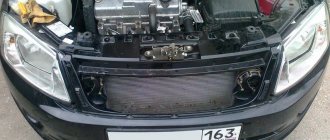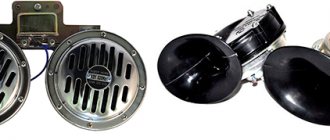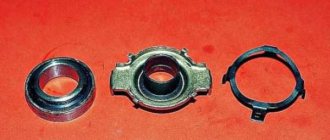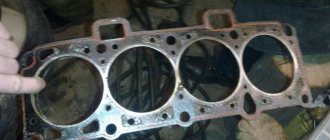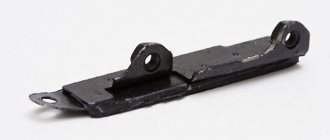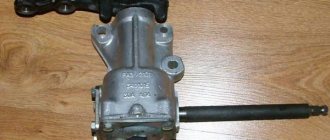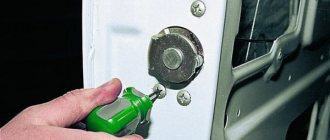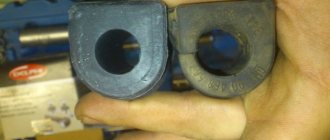Sound signal device
The sound signal on the VAZ 2107 comes in the following versions:
- Two separate signals: type S-304 (low tone) and S-305 (high tone). Mounting - on the bracket, to the left of the radiator.
- The only non-separable signal of type 20.3721-01, one tone, with a built-in relay. Mounting is on a bracket outside the radiator, immediately behind the decorative grille.
The operation diagram of the sound signal is as follows: two wires are connected to the sound signal itself. The red wire is “plus”. This part of the circuit is constantly energized. The gray-black wire is “ground, minus”; in the normal state it is de-energized, and current begins to flow through it when shorted. The photo clearly shows the color of the wires and two separate signals with brackets.
The “negative” part of the chain is long. When you press the central steering wheel button, the spring contacts close. They are located in the switch housing under the steering wheel.
The slip ring is attached to the back of the steering wheel. Its task is to ensure good contact through friction and provide a signal whenever the steering wheel is turned. Therefore, the ring must be lubricated with conductive graphite lubricant to avoid wear.
Then, the current is transmitted through the wire as part of the engine compartment harness to the switch and relay mounting block. The location of the horn relay (switch) is third on the right (if you are sitting behind the wheel).
Horn relay functions:
- The length of wires and current losses in them are reduced.
- With the help of a relay, a button with a small current can control a circuit with a large load.
Sometimes the circuit does not provide a relay; instead, a jumper that is connected “directly” works. In the case of a single signal 20.3721-01, this is justified, since it has a built-in relay. If there are two “snails”, it is advisable to install a relay to improve operation.
After the relay, the current passes through fuse F7. The new mounting blocks have a 20 A flag-type fuse, yellow. Older units have 16 A fuses. Their lifespan is often insufficient, since this fuse also serves in the cooling fan circuit.
Further, after leaving the mounting block as part of the wiring harness of the engine compartment, the “negative” wire goes directly to the sound signal.
Where is the signal located on a VAZ-2107 car?
The domestic automaker is releasing to the market several modifications of the VAZ-2107 car model, which is beloved by consumers. The design and location of each of them has a number of its own features:
- in some versions of the car, only one sound signal is used, which is mounted immediately behind the front lining of the cooling radiator. In this case, you can easily reach the part and replace it if the need arises;
- A number of modifications are equipped with two sound signals at once. They are installed directly behind the radiator and have different tones, which makes it possible to quite loudly warn pedestrians and drivers of other cars about the possible danger of a collision.
The RS-528 sound signal relay is mounted in the mounting block of both machines, which is often one of the main causes of breakdowns of this part.
Checking operation and repairing in case of sound signal malfunctions
There are three malfunctions: it doesn’t sound when needed; works when not needed, or sounds intermittently, hoarsely, quietly. Unlike the high-voltage ignition system, which is little affected by the quality of the connection, the horn system is low-voltage. This means that the film of oxides and rust significantly impedes the passage of current. But signals are a powerful current consumer. The current in the circuit is at least 4-5 A.
The quality of all contacts must be perfect, otherwise repairs will be needed constantly. Remember that the car body itself is a “negative” contact, and in the direction of current movement, all oxides settle on the “plus”. Pay special attention to stripping the terminals of the red, “positive” wire.
The “negative” part of the chain is longer. Therefore, most often this is where malfunctions occur. Therefore, it is immediately necessary to check the serviceability of the signal and look for an open circuit. To do this, you need to attach the gray-black “negative” wire from the sound signal to a cleaned place on the case, i.e., “short to ground,” and the “positive” wire directly to the battery. Then turn on the ignition. If there is sound, it means there is a break somewhere in the negative circuit. If there is no sound and the positive terminals are cleaned, then the signal itself is faulty.
Common faults:
- fuse blown (replace)
- The contacts have oxidized, or the relay has burned out (needs replacement).
- if there is a jumper, the contacts have oxidized and weakened; clean or change;
- the paddle on the switch under the steering wheel is broken, the slip ring on the steering wheel has worn out (this happens when the car wears out significantly, and also among those who like to honk constantly).
see also
Comments 36
new car with old type of fuses, is this a joke?
I also tried to remove the jumper and install a relay, it didn’t help, and I did it according to the scheme www.drive2.ru/l/288230376152333716/ 1 year we’ve been buzzing, no problems)))
— Minimum jumpers — Used a relay
The bottom line is that the contacts from the native signal feed the switch to turn on. At the moment of switching on, it supplies the signal itself through the contact group.
Next, attach the negative bolt (aka fastening bolt) to the body somewhere.
From the battery (through the fuse) you lead the plus to pin 30 of the relay, from 87 you feed the terminal on the signal.
And everything will work!
Instead of a jumper, you put a relay, and the polarity on the wires changes, then the wire that was “-” became “+”, and vice versa - which was “+” became “-“, + you aim the wire, bolt the ground onto the body, and there you have it joy:)
Hello. well, bring in your idea))) only with a little blood)))
read the PM! I will say this with very little blood
Hello. well, bring in your idea))) only with a little blood)))
I installed it myself, you take out the jumper and install the relay, now the wire that was ground has become a plus, you put the signal lights with a minus on ground, and the resulting plus goes to the signal lights, and everything is ok, if anything is not clear, ask.
just take a 3-pin Volgov relay and you will be happy;) you connect 2 stock wires to it, 3 lead to a signal
The whole problem is that in your wiring the signal is controlled by a negative signal (“-“). The minus is closed through the steering wheel.
In general, I wrote a detailed and simple article especially for such cases. www.drive2.ru/l/4514195/ - this one.
Your relay should fit the mounting block.
AND? buzzes without pressing the signal))))
I have already corrected my mistake)))) By deleting the comment))) I didn’t quite understand what kind of circuit it was, since I used a relay in the signal, I decided that I would still remain silent)))))
Isn’t it easier not to bother with the original unit, but simply connect the original wires (which go to the signal + and -) to the relay at terminals 85 and 86, and you can run one wire from the battery to terminal 30 through a fuse and, accordingly, another wire from terminal 87 on the new signals themselves. The relay can be placed under the hood along with the wires.
About the VAZ 2107 sound signal: features of repair and modernization
Although the sound signal on a car plays a secondary role, driving a vehicle with a faulty signal is prohibited by traffic rules. Owners should regularly check the serviceability of the sound alarm, and this is especially true for outdated car brands, such as the VAZ 2107. If the signal on the VAZ 2107 does not work, then do not despair, sometimes it takes no more than 5 minutes to fix the breakdown. We will find out in detail what types of signal malfunctions occur on sevens.
Horn functions
The signal is provided to anticipate the danger of an accident, as well as to warn pedestrians about the possible danger. The signal is received by pressing a button mounted on the steering wheel. Traffic regulations limit the use of the signal to 2 situations. The first involves informing the driver of the car being led before the maneuver. The situation falling under paragraph 2 of the traffic rules is more extensive. The following are likely:
And there are many similar situations. Justified and timely use of a sound signal will protect road users and help avoid possible danger.
Sound signal device for VAZ 2107
VAZ 2107 cars are equipped, depending on the year of manufacture, with two versions of the sound alarm. On models since 2000, a sound signal is installed on the VAZ 2107, consisting of two separate devices. One source produces low tones, and the second high. The devices are fixed directly to special brackets and are located on the left side of the radiator, under the grille.
Early models of VAZ 2107 cars are equipped with non-separable sound emission sources that produce only one tone. The product is also mounted on the front part near the radiator. The connection diagram of the element is simple, and in case of failure, eliminating the damage will not be difficult.
The sound signal device for 2 sources has the following form:
- Two wires are connected to the source of sound creation. One of the wires is red and the other is black. The red wire is the positive contact, which is constantly energized with 12V.
- The second wire is “minus” - it is de-energized and turns on only when the contacts are closed. As soon as the contacts are connected, current is supplied to the equipment, thereby generating sound vibrations.
The contacts are located on the steering wheel, and when you press the button, they close. Springs with a slip ring are used as contacts. The contact ring is located on the back of the steering wheel and provides high-quality contact when pressing the button. In addition to sources and a button, the design of the VAZ 2107 sound alarm also includes a relay and a fuse. The relay is designed to reduce the amount of current flowing to the device button.
Installing an additional button on the VAZ 2107 sound signal
The movable contact of the steering wheel with the steering column of the VAZ 2107 fails over time. His foot loses flexibility and the contact parts no longer touch. To prevent this from happening, car owners often install an additional button to turn on the sound signal, duplicating the function of the button on the steering wheel, that is, connecting the relay to ground. Installed in any convenient place, usually on the dashboard near the steering wheel.
This button can be set as follows.
- Let's make a hole of a suitable diameter on the dashboard.
- Place the button in the hole you made.
- If the button is three-contact, determine which contacts close when the button is pressed. This can be done using a multimeter.
- In the general wiring harness, locate the wire that goes to the steering sound sensor button. This wire is usually gray with a black stripe.
- Connect this wire or a parallel wire to one of the button contacts.
- Connect this wire or a parallel wire to one of the button contacts.
A button connected in this way will perform the same functions as a button on the steering wheel.
Personal experience shows that using the signal button installed on the dashboard is inconvenient. You won't get used to it enough to squeak without looking at it. As a result, you lose precious fractions of a second that could be extremely important. It's worth spending the money and spending some time to fix your steering wheel horn.
The signal does not work on the VAZ 2107: repair from A to Z
The sound signal, also called a horn, plays an important role in ensuring safety on the road, as it makes it possible to attract the attention of other road users. The article discusses the situation when the signal does not work on a VAZ 2107: causes of malfunctions, methods of elimination, the possibility of its repair and replacement.
Sound horn on VAZ-2107: causes of malfunction
In order to find out whether your car uses a correctly working signal, you should disconnect its wires from the relay and connect them directly to the battery. If the sound does not appear in this case, the causes of the breakdown may be the following:
Troubleshooting is done by adjusting the signal (to do this you just need to turn a special screw installed in the back of the case) and cleaning the contacts.
Another reason why the signal may not work is a broken or worn button. To restore its normal functioning, you can either replace the entire part, or again put the contacts to which the wires are connected in perfect order.
Possible malfunctions: signs and causes
In order to understand the reasons why the horn does not work, you need to understand the VAZ 2107 signal circuit:
The circuit consists of the following components:
- sound devices;
- mounting block;
- jumpers for contacts installed in place of the relay;
- signal switch.
The sound signal is activated by a button located in the center of the steering wheel.
There is a contact ring on the steering wheel, and a spring-loaded contact in the area of the steering column switches. Modern alarm devices are equipped with an adjusting screw for adjusting the volume and a built-in relay (in the mounting block, the relay outputs for the sound signal are short-circuited with a jumper).
- no sound when pressing a button;
- The sound does not turn off or turns on randomly;
- hoarse, quiet or intermittent sound.
The audio system carries low voltage current, so the quality of the connections is important. If there is a large amount of oxides and rust on the contacts, then the passage of current becomes difficult. Klaxons require a powerful current of at least 4-5 A.
It is necessary to carefully monitor the cleanliness of connections and terminals, otherwise repairs will be needed constantly. Since the car body acts as a minus, and oxidation settles on the plus, special attention should be paid to stripping the terminals on the positive red wire.
The negative branch of the chain is the longest, so it is most likely to have a break. To determine the cause of the malfunction, you need to connect the gray-black wire coming from the signaling device to the body, and the positive wire directly to the battery. Then the ignition is turned on. If the sound appears, it means there is a break in the minus value. If there is no sound and the positive terminals are cleaned, then the device has failed.
If the sound signal on a VAZ 2107 does not work, the following malfunctions are possible:
- fuse is blown;
- contacts and terminals have oxidized;
- the relay has failed;
- the connections on the jumper, if present, have oxidized;
- the paddle on the steering column relay broke;
- development of a slip ring.
After diagnostics, the faults found should be eliminated (video author - Alex Life).
Video “Checking and repairing the VAZ 2107 signal”
This video demonstrates how to diagnose and repair the horn on a VAZ 2107 (the author of the video is DamirBikmetov).
Two types of sound signals can be installed on a car: a double signal, consisting of two signals of different tones and mounted on a bracket near the radiator in the engine compartment, or a single signal, which is also mounted on a bracket between the radiator and the radiator grille. Removing the sound signal of the VAZ 2107 is carried out in the event of its failure for subsequent replacement. The signals cannot be repaired and if something happens they are simply replaced with new ones.
The signals are switched on using an auxiliary relay and a switch that closes the negative terminals to vehicle ground. During operation, the sound signal membrane gradually loses its elasticity and the tonality has to be adjusted. If the car has a double signal, then they must be adjusted one by one, and the help of an assistant will also be required.
The procedure for adjusting the sound signal is as follows:
- The two signals are adjusted separately, which means we disconnect one sound from the power supply.
- We put the assistant in the car so that he turns on the signal.
- Using a flat-head screwdriver, rotate the screw located on the signal housing in both directions and achieve optimal sound.
- We do the same with the second one.
If your car has a single horn, you will have to remove the radiator grille. The adjustment work is identical.
If you need to replace the sound signal, you must:
- We disconnect the supply wires, having previously marked them with a marker so as not to confuse them during further connections.
- Using a thirteen-size wrench, unscrew the nut securing the signals to the bracket and remove it.
At this point, work on removing and adjusting the VAZ 2107 sound signal is completed. Installation is carried out in the reverse order of removal.
From a road safety perspective, the horn plays an important role in preventing road accidents. On a VAZ-2107 car, depending on the modification, two sound signals of different tones can be installed behind the radiator of the cooling system, or one sound signal, which will be installed behind the front radiator trim.
To put it into operation, a horn button is installed on the steering wheel, and a fuse F7 (20A) and a horn relay RS - 528 are installed in the mounting block. But on some VAZ-2107 cars this relay will not be installed, and in its place there will simply be stand jumper.
If there is no sound signal, troubleshooting should begin by checking the fuse . You need to look not only whether it has burned out or not, but also the condition of its contacts. The horn relay, if your car has one, can be checked quite simply; when you press the horn button, it should click; if the click is not heard, you will have to replace it.
The sound signals themselves can be checked without removing them from the installation site. To do this, disconnect the wires going to it and connect the horn directly to the battery . If there is no signal, a possible malfunction may be burning of the contacts located inside the audio signal housing or a violation of its adjustment. You can adjust the tone by turning the adjusting screw located at the back of the horn housing and gently turning it in one direction or the other.
Another reason for the signal not working may be the power button itself . You will have to remove it and check the condition of the contacts. Malfunctions that arise in the operation of the sound signal on a VAZ-2107 car can easily be corrected by the driver himself.
Methods for troubleshooting
If a fuse or relay has failed, they must be replaced with new parts. If the slip ring is worn out, then it is unlikely that you can repair the steering wheel, since the slip ring is difficult to find on sale. In this case, the most reasonable thing is to replace the steering wheel.
If the horn makes hoarse sounds or turns on intermittently, you should use a multimeter to check whether the battery is charging and the voltage is flowing to the terminals. If everything is fine with the power supply, the reason may be in the sound device itself. There is a screw on the horn body to adjust the volume. It should be rotated until the wheezing disappears and the sound becomes loud.
If adjusting the volume does not help eliminate the wheezing, you will have to disassemble the device to clean the contacts. You can also replace the membrane. Sometimes hoarse sounds appear when starting the engine. In this case, it is necessary to check the condition of the breaker contacts and the top plate. The contacts should be thoroughly cleaned and the plate replaced if necessary.
Signal interchangeability
If the alarm device cannot be repaired, it must be replaced with another one.
All modern horns can be divided into two types: pneumatic and electromagnetic (video author - Russia 24).
In the first type of sound signals, the air flow moves from the compressor through a pipe, which, under the influence of vibration, begins to make sounds. Pneumatic devices differ in the shape of the tube and the power of sound. The frequency range of the audio signal covers several audio zones. Several pipes can be installed, but they require a powerful compressor.
The operation of an electromagnetic device is based on an electromagnet, which is connected to the main element of a horn of this type, a membrane. The core winding is connected to a power source (battery) using a breaker. The horn button is connected to ground. When you press it, the core rod begins to move, thus exerting an effect on the membrane. The result is a powerful sound.
Electromagnetic horns differ in the design of the sound emitter:
- Disc horns (“pancakes”). They are manufactured in two versions: non-separable and collapsible. In addition, it can be closed or open.
- Snail sounds. They are curved, making them difficult to install. The open end of the socket should point forward. “Snails” make it possible to get a very loud sound.
- Horns have a tube that looks like a straightened snail. Outwardly they look like a horn or a trumpet. They are convenient to install under the hood, but their sound power is weak.
When choosing a sound device, you should pay attention to several nuances:
- Before purchasing, you should evaluate the capabilities of the battery. It is important that its charge is sufficient to power the buzzer, as it consumes a large amount of energy.
- You should check with the seller whether the horn needs additional power or a compressor.
- High frequencies produce a subtle sound. Low frequencies are suitable for bass lovers.
- It must be remembered that trucks have a 24 V on-board network, and passenger cars have 12 V. It should be noted that the use of “quacks” and special signals is prohibited.
About the signal of the domestic VAZ-2107
The manufacturer equipped the 2107 VAZ 2 models with 2 signal modifications:
- The first option is equipped with 2 sound elements. They have low and high tonality (S-304, S-305). This made it possible to obtain surround and loud sound. These components were equipped on a metal bracket under the hood near the cooling radiator.
- The second option involved installing one signal labeled 20.3721-01. It is also located on a metal bracket in the place where the cooling radiator is located. By the way, all sound parts are non-separable and therefore cannot be repaired.
The feasibility of self-repair
Self-repair is possible if the driver is well versed in electrical engineering. Car enthusiasts who do not have such skills can replace a fuse, relay or clean the terminals.
If the contacts are not oxidized, but burned out, then it is easier to install a new signaling device. If you know how to make a signal on a VAZ 2107, you can do the repairs yourself - this will give you the opportunity to gain experience in electrical repair work and save money at the service station.
If the signal on a VAZ 2107 is lost, it should be repaired as quickly as possible, since its malfunction increases the risk of an accident.
In addition, according to traffic rules, operating a car without a sound signal is prohibited. Therefore, it is impossible to pass a technical inspection with a faulty horn.
